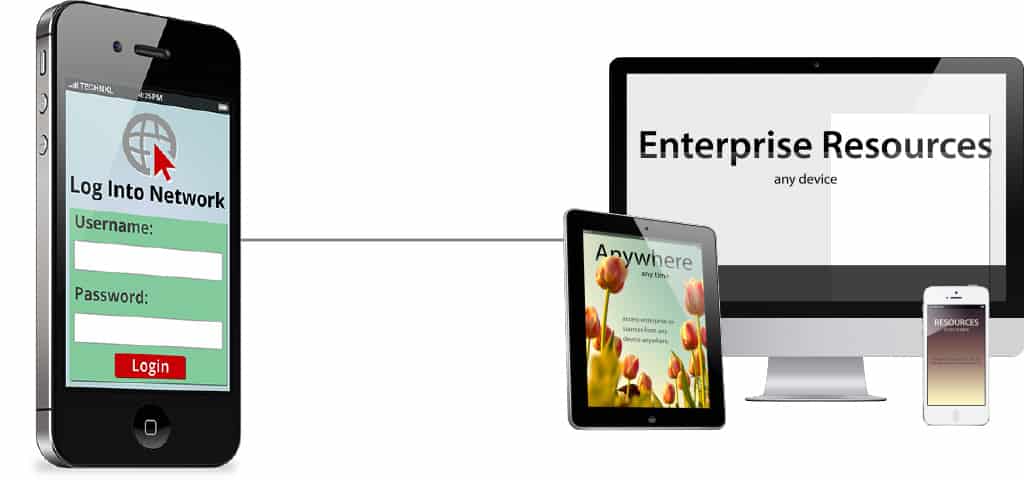So far I’ve introduced the topic mobile learning in the enterprise and the challenges and barriers we may experience.
If you haven’t read the first two, I’d recommend starting there before reading this post. Start with the Introduction to Mobile Learning in the Enterprise, then read Challenges and Barriers to Mobile Learning in the Enterprise.
It takes many departments within an enterprise to break down mobile barriers. Opening the network to employees isn’t going to happen unless there is something to open it up to.
To simplify the solution into a few sentences, start by making resources compatible with mobile devices. After they’re compatible, open it to employees beyond just VPN (jargon, yes, so avoid it) access.
As I mentioned in an earlier post, tracking all learning isn’t necessary. This alone will be one less barrier that’s prevalent in all enterprise learning (control). Once we accept that tracking in many cases is unnecessary, we’re free to offer content that’s really important.
Now let’s look at solution details of challenges and barriers I presented in the last post.
Public Domain
The solution to this problem is fairly straight forward and easy to talk about. Unfortunately, it’s not so easy to execute. Even if it’s not easy to execute, it’s a necessary first step to move towards the mobile enterprise.
Take that internal domain (http://intranet) and ban it from existence, not too hastily though, make sure you’re content is still available or you’ll have bigger problems.
Move everything to an external domain first. All content should be accessible through an external domain such as http://intranet.domain.com. If there’s much content that links to a static page (IE. http://intranet/folder/file.html), fix it, all of it. You have to do this and you can’t get past it, you’ll never make a mobile enterprise otherwise.
Once resources are moved to a public domain, even if still behind a firewall, you’re in a good place to work with necessary departments to open the firewall.
How are resources protected if there’s no firewall protecting it?

The ideal user experience has no barriers beyond a simple login screen. On the other side, content adjusts to the device it’s being shown on, no matter what size, even devices that aren’t invented yet.
Password Protect Your Resources
Now that your data is theoretically accessible outside your enterprise network, it still has the firewall, but no way to protect the resources from the public.
This can be solved by password protecting resources. Employees already have a username and password to use their computer at work, and possibly access the network remotely. This can be used to protect resources from non-employees.
After your resources are password protected and necessary security precautions taken to make sure everything will stay safe, it’s time to lower the firewall and let your content shine to all your mobile users.
This is great for employees that might be using a tablet device and great in general because you’re one step closer, but it’s still not so great for the employee using a mobile phone. Here’s the next step to solve that.
Device Compatibility
Make resources available to everyone, no matter what device they use.
What does that mean?
Don’t use Flash, design your content for mobile first.
If you must use Flash, make sure it’s labeled specifically as mobile inaccessible before the user gets to the content, greeted with a nasty incompatibility message. If they see this error, the user experience is destroyed.

It might be helpful to the user if resources are marked as mobile incompatible before clicking too far. This will save the user time and create a better user experience.
Solving device compatibility wasn’t easy in 2007, nor was it expected. If you recall the original iPhone ads showed how easy iOS made accessing desktop formatted content on a smart phone. The user shouldn’t have to jump through hoops to use your content, it should be there and work for their device.
Things such as adaptive and responsive web design have become common. While I would discourage adaptive design, it could be a practical solution for some.
Responsive Web Design is the ideal solution to make content compatible with all devices, even if they haven’t been invented yet.
You can find many resources on Responsive Web Design all over the Internet, even on a few of my posts, I’d recommend my post on the future of learning online: responsive learning design which also has a few links to other resources.
Break The Network Open
Solving the problem of the closed enterprise network is a process that requires many steps. Some departments are less than excited to open the network to devices they don’t have control over. Control is not what it’s all about anymore, open is the only way to go.
By creating responsive resources and making them compatible with all these new devices that users want to use, you’re showing the enterprise what an important asset mobile is with great ROI.
If one department is holding mobile development back, do what you can, they will have to follow eventually, it’s too powerful not to.
An open network still has precautions in place, but only necessary one’s. That means a username and password, this is all an employee should need to use enterprise resources.
Ditch the Barriers
Solve the user experience problem by removing forms, the need to set up devices, and multiple login screens. If the user needs to sign in more than once or jump through any hoops to use work stuff with their personal device, you’ve lost them and their device.
Take the learning wall down immediately. To be a mobile enterprise, there can’t be a wall. Employees want to use their personal device on our network, for work, that’s a promise of great ROI. It helps them and helps us. A BYOD (Bring Your Own Device) policy is not complete without enabling the user in any way possible to use it, without barriers.
Wrap Up
I’ve covered much information in the three posts about the mobile learning enterprise. Much of this does not only apply to learning, but also the mobile enterprise.
I hope I have sufficiently answered the question I initially proposed: How do we break down the wall and get enterprise resources to all employees?
In the second post. I covered problems you’re likely to see in the enterprise when trying to make the mobile enterprise. Problems are a great thing to talk about, but even better are solutions to those problems which I covered in this post.
If you have anything to add to my mobile enterprise monologue, I would love to turn this topic into a continuing dialogue. Your comments are always appreciated. I’m very interested in what has been accomplished out there, and how.
I invite you to continue this conversation in the comments section of any of these three posts, or continue the discussion on Twitter, you can always find me @technkl.